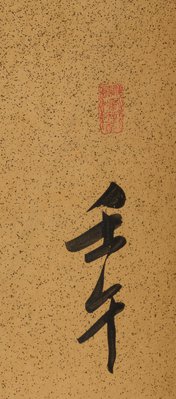


-
Details
- Place where the work was made
-
China
- Date
- 1882
- Media categories
- Scroll , Calligraphy
- Materials used
- pair of hanging scrolls; ink on paper
- Dimensions
-
203.5 x 87.0 cm overall (variable)
:
a - right scroll, 170.5 x 35.6 cm, image
a - right scroll, 203.5 x 43.5 cm, scroll
b - left scroll, 170.5 x 35.6 cm, image
b - left scroll, 203.5 x 43.5 cm, scroll
- Signature & date
Signed c.l. part b, in Chinese, inscribed in black ink "...Huang Nong, Xu Qi".
Signed l.l. part b, in Chinese, stamped in red ink “Chen Xuqi yin [artist's seal]".
Signed l.l. part b, in Chinese, stamped in red ink “Gengchen hanlin [artist's seal]".
Signed u.r. part a, in Chinese, stamped in black ink "Verse assembled from the ‘Yilin’ in the winter of the year of Renwu (1882)"- Credit
- Gift of Dr. James Hayes 2005
- Location
- Not on display
- Accession number
- 248.2005.a-b
- Copyright
- Artist information
-
Xu Qi
Works in the collection
- Share
-
-
About
‘The elder sing, the younger dance, everyone is full of happiness and joy;
Carrying wine on the left, tart drink on the right, we greet our fortune.’
Inscription and signature: Verse assembled from the 'Yilin' in the winter of the year 'renwu' [1882] by Xu Qi, alias Huanong.The couplet was made up of poetry taken from the ‘Yilin’ (Forest of changes), written by Jiao Gan in the 3rd century BCE. Jiao’s text is a creative interpretation of the ‘Yijing’ (or I ‘Ching’, ‘Classics of change’), the oldest of the Chinese classic texts describing a system of divination and philosophy centred around the ideas of balance through opposites and acceptance of change. The ‘Yilin’ expands the ‘Yijing’s 64 changes into 4096 possible variations, each interpreted by a verse. Taken from two separate verses describing the happiness felt at a family gathering, this couplet would be suitably displayed for a festive occasion.
Xu Qi (alias Huanong) grew up in a prestigious family of scholar-officials in Hangzhou. He obtained the ‘jinshi’ degree in the year of ‘gengcheng’ (1880), a fact also revealed in one of his seals stamped on the couplet. Thus from his great grandfather Xu Chao to himself, the family contributed six ‘jinshi’ and members to the Imperial Hanlin Academy. Xu held various administrative appointments, including Guangdong provincial director of education, junior vice-minister for the Ministry of War, and sub-chancellor of the Grand Secretariat. His graceful calligraphy is seen in many public places in Guangdong and Hangzhou. One example is at a Buddhist temple site called Longqiutan in Lanzhou, Guangdong, where his huge running script of Tang poet Han Yu’s (768–824) poem is carved on the side of a cliff.
‘The Poetic Mandarin: Chinese Calligraphy from the James Hayes Collection’. pg.98.
© 2005 Art Gallery of New South WalesThe couplet, written on two narrow pieces of paper or silk, and hung either side of a large painting or doorway, is one of the most common forms of calligraphic art and has a long standing history in China. They first appeared in the Five Dynasties period (907-979) as pairs of plaques, carved after written master copies, to decorate architectural columns, courtyards and garden doorways. Couplets for indoor display, written on paper or silk, came into existence in the 17th century and gained great popularity in the Qing dynasty. The couplets themselves are either taken from classical poetry or contemporary literary works composed by the calligraphers themselves and their friends. A couplet is made up of two parts called the head and the tail. The two lines of verse are antithetically parallel. Formerly it was a very common practice to send them to friends or relations on such occasions as marriages and birthdays, or as condolences to families of deceased persons.
Asian Art Department, AGNSW, August 2003.
-
Places
Where the work was made
China
-
Exhibition history
Shown in 1 exhibition
The poetic mandarin: Chinese calligraphy from the James Hayes collection, Art Gallery of New South Wales, Sydney, 23 Sep 2005–27 Nov 2005
-
Bibliography
Referenced in 1 publication
-
LIU Yang, The poetic mandarin: Chinese calligraphy from the James Hayes collection, Sydney, 2005, 98, 99 (illus.). cat.no.26
-
